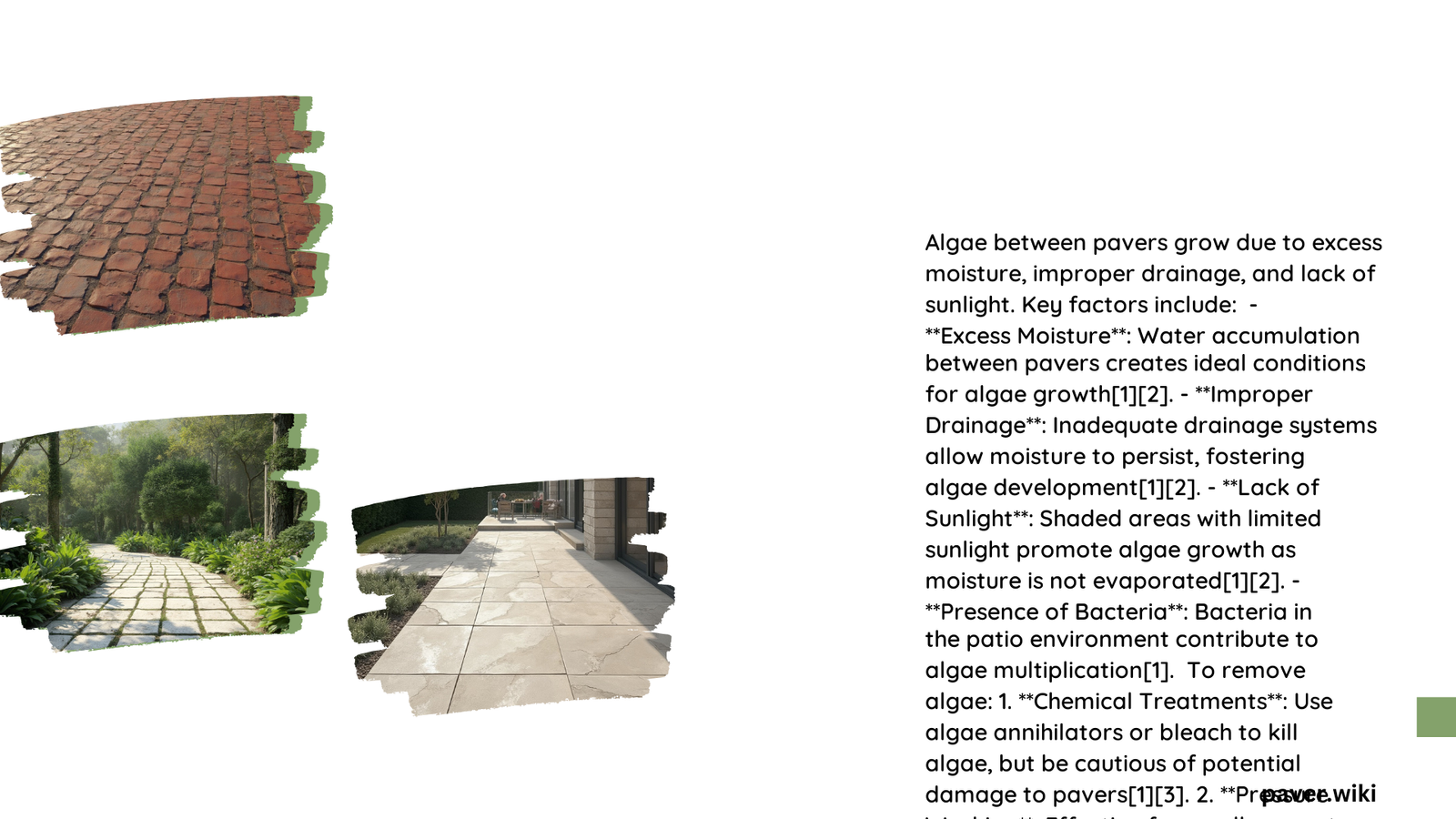Algae growth between pavers is a common issue for homeowners and landscapers. These microscopic organisms thrive in damp, shaded areas, often appearing as green or black slippery patches. Algae between pavers not only detracts from the aesthetic appeal of outdoor spaces but can also create safety hazards due to their slippery nature. This comprehensive guide explores effective methods for removing algae from pavers and preventing its regrowth, ensuring your outdoor surfaces remain clean, safe, and visually appealing.
What Causes Algae Growth Between Pavers?
Algae thrive in environments that provide moisture, shade, and organic matter. Several factors contribute to algae growth between pavers:
- Poor drainage
- Lack of sunlight
- High humidity
- Accumulation of organic debris
Understanding these factors is crucial for effective algae prevention and removal.
How Can You Identify Algae Between Pavers?

Identifying algae between pavers is the first step in addressing the issue. Look for:
- Green or black slimy patches
- Slippery surfaces, especially when wet
- Discoloration of paver surfaces
- Musty odor in the affected area
What Are the Most Effective Algae Removal Techniques?
1. Power Washing
Power washing is a highly effective method for removing algae from pavers. Here’s how to do it:
- Set up the power washer with appropriate pressure settings
- Use a wide fan nozzle to distribute pressure evenly
- Start from one corner and work your way across the paved area
- Be careful not to dislodge sand from between pavers
Pros:
– Quick and efficient
– Removes stubborn algae growth
Cons:
– May require equipment rental
– Risk of damaging pavers if not used correctly
2. Chemical Treatments
Chemical treatments can be effective in killing and removing algae. Here are two common options:
Wet & Forget Outdoor Concentrate
- Mix 1 part Wet & Forget with 5 parts water
- Apply using a garden sprayer
- Allow the solution to work over several weeks
Bleach Solution
- Mix 1 part bleach with 9 parts water
- Apply to affected areas
- Let sit for 24 hours before rinsing
Note: Avoid using bleach on artificial pavers as it may cause discoloration.
3. Eco-Friendly Alternatives
For those seeking environmentally friendly options, consider:
Vinegar Solution
- Mix 1 part vinegar with 9 parts water
- Apply and scrub with a brush
Baking Soda Paste
- Create a paste with baking soda and warm water
- Apply to affected areas and scrub
These methods are safe for pets and plants but may require more effort.
How Can You Prevent Algae Growth Between Pavers?
Prevention is key to maintaining algae-free pavers. Here are some effective strategies:
- Improve drainage around paved areas
- Ensure adequate sunlight exposure
- Regularly clean and sweep paved surfaces
- Apply anti-fungal sealers to pavers
- Use polymeric sand in paver joints to reduce moisture retention
| Prevention Method | Effectiveness | Ease of Implementation |
|---|---|---|
| Improve drainage | High | Moderate |
| Increase sunlight | High | Varies |
| Regular cleaning | Moderate | Easy |
| Anti-fungal sealer | High | Moderate |
| Polymeric sand | High | Moderate |
What Are the Environmental Impacts of Algae Removal Methods?
When choosing an algae removal method, consider its environmental impact:
- Power washing: Low impact if done correctly
- Chemical treatments: Potential harm to soil and water ecosystems
- Eco-friendly alternatives: Minimal environmental impact
Always follow local regulations regarding chemical use and runoff management.
How Often Should You Clean Pavers to Prevent Algae Growth?
Regular maintenance is crucial for preventing algae growth. A general guideline is:
- Sweep weekly to remove debris
- Clean thoroughly every 3-6 months
- Inspect for algae growth monthly, especially in shaded areas
Adjust this schedule based on your specific climate and paver conditions.
What Tools Are Necessary for Algae Removal?
To effectively remove algae from pavers, you’ll need:
- Power washer (for power washing method)
- Garden sprayer (for chemical applications)
- Stiff-bristled brush
- Protective gear (gloves, goggles)
- Cleaning solution of choice
Having these tools on hand will make the algae removal process more efficient and effective.
Can Algae Between Pavers Cause Structural Damage?
While algae itself doesn’t directly cause structural damage to pavers, it can lead to:
- Increased moisture retention, potentially weakening the paver base
- Slippery surfaces, creating safety hazards
- Staining of paver surfaces
Addressing algae growth promptly can prevent these secondary issues from developing.
By understanding the causes of algae growth between pavers and implementing effective removal and prevention techniques, you can maintain beautiful, safe, and clean outdoor surfaces. Regular maintenance and prompt attention to algae growth will ensure your paved areas remain in top condition for years to come.
References:
1. Wet & Forget: Remove Algae and Lichen off Patio Pavers
2. proPERLA: How to stop green mould from growing on your patio?
3. Christie’s Landscapes: How to Clean Your Paving Slabs Without Using Chemicals?
